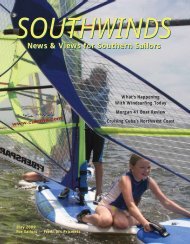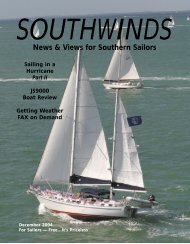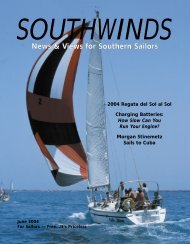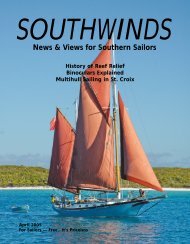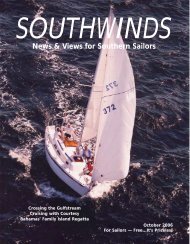News & Views for Southern Sailors - Southwinds Magazine
News & Views for Southern Sailors - Southwinds Magazine
News & Views for Southern Sailors - Southwinds Magazine
- No tags were found...
You also want an ePaper? Increase the reach of your titles
YUMPU automatically turns print PDFs into web optimized ePapers that Google loves.
Mills’ yard in the 1950s, Clearwater BayMarine Ways, Inc. Mills ran the yard withFrank Levinson.left Philadelphia, and moved to the PanamaCanal Zone as a shipwright. He faced newchallenges and continued to increase hisbuilding skills. In his spare time, he built an18-foot sailboat from scraps in order to sail thewaters of the Canal Zone. When the warended, he returned to Clearwater to seewhether or not he could make a living designingand building boats. Whether or not he was a third-classbuilder when he started in Philadelphia, clearly he was nowa first-class boatbuilder.I met Clarke In 1946 when I first discovered sailing. Iwas 11. I’d get off the school bus, walk across the ClearwaterYacht Club grounds to the old fish house shed, a cavernoustin building where in the dark back corner Clark Mills wasbuilding a small 24-foot sailboat. A little light crept inthrough the crazed windows, but the main light was fromtwo small naked bulbs hung over the work. Clarke likedvisiting as he worked. He could maintain a lively conversationwhile his hands deftly crafted the next piece <strong>for</strong> theboat. He loved wood, all species of wood, but especiallyordinary woods like pine, oak, cypress and fir plywood. Heunderstood wood, and it understood him. It responded tohis touch. The result was always smooth curves and tightfittingjoints. He learned from his family to work hard, butalso to take time to play. He described “gunkholing” in asailboat as “sailing down the coast, and when you see someone,or something on shore that interests you, you drop theanchor and go ashore and spend a few days.” As he worked,he had time to talk—talk about sailing and boats, talk aboutbuilding boats, talk about Florida and how it was when hefirst arrived in the 1920s. He was friendly and gregarious.He loved life, and he loved his work.Around us in the old fish house were racing Snipes restingon their trailers. Clarke didn’t race, but he had repairedmany of these boats. When he built a couple of racingSnipes <strong>for</strong> local men, the boats sailed so well that he soonhad orders that would take him more than a year to build. Iasked him about “Mills Snipes.” Had they a flatter keel withless rocker? Did he build them fuller in the bow? Whatmade them sail fast? In his usual modest manner, heanswered, “Shucks, I just try to get them inside the narrowtolerances of class measurements. I’m just glad if they ‘measurein.’ ”He had a great sense of humor and loved to laugh. Heproposed the first movable ballast <strong>for</strong> a sailboat. “You loadthe bilge with turtles. When you tack, they’ll crawl up to thehigh side.”The idea <strong>for</strong> the Optimist Pram started with my father,Major Clif<strong>for</strong>d McKay. His concept came from the Soap BoxDerby, a race <strong>for</strong> small gravity-powered cars. In August of1947, he proposed to the Clearwater Optimist Club a smallsafe, simple boat that a boy could build. It needed to beinexpensive. It should be built of 4’ x 8’ plywood and cost$50. Merchants would sponsor the boat, and every boy andgirl could have one to sail. Dad, who was not a sailor, suggesteda bed sheet <strong>for</strong> the sail. Said Clarke, “I talked him outof the bed sheet.”Clarke said of his design, “I had a little knockaboutrambling about in my head. I lopped off the bow to fit the 4x 8 plywood. It looks a little funny, but it sails real good.”The sprit rig keeps the center of ef<strong>for</strong>t low, which, matchedwith the 3’ 10” beam, provides remarkable stability. Clarketook Dad’s parameters and created the safe, lively, inexpensive,fun-to-sail little boat that took the world by storm.Dad’s original idea was <strong>for</strong> the boys to build their ownboats, but that never happened. For the first boats, ClarkeWhat a concept!It is engineeredto be easily serviced.• Beta Marine supurb propulsionengines using Kubota diesels• From 13.5 to 105 HP including ourfamous Atomic 4 replacements• 150 HP using Iveco diesel• Also available: marine generators up to 30KwBeta Marine US, Ltd.PO Box 5, Arapahoe, NC 28510877-227-2473 • 252-249-2473 • fax 252-249-0049info@betamarinenc.com • www.betamarinenc.com<strong>News</strong> & <strong>Views</strong> <strong>for</strong> <strong>Southern</strong> <strong>Sailors</strong> SOUTHWINDS May 2012 47



